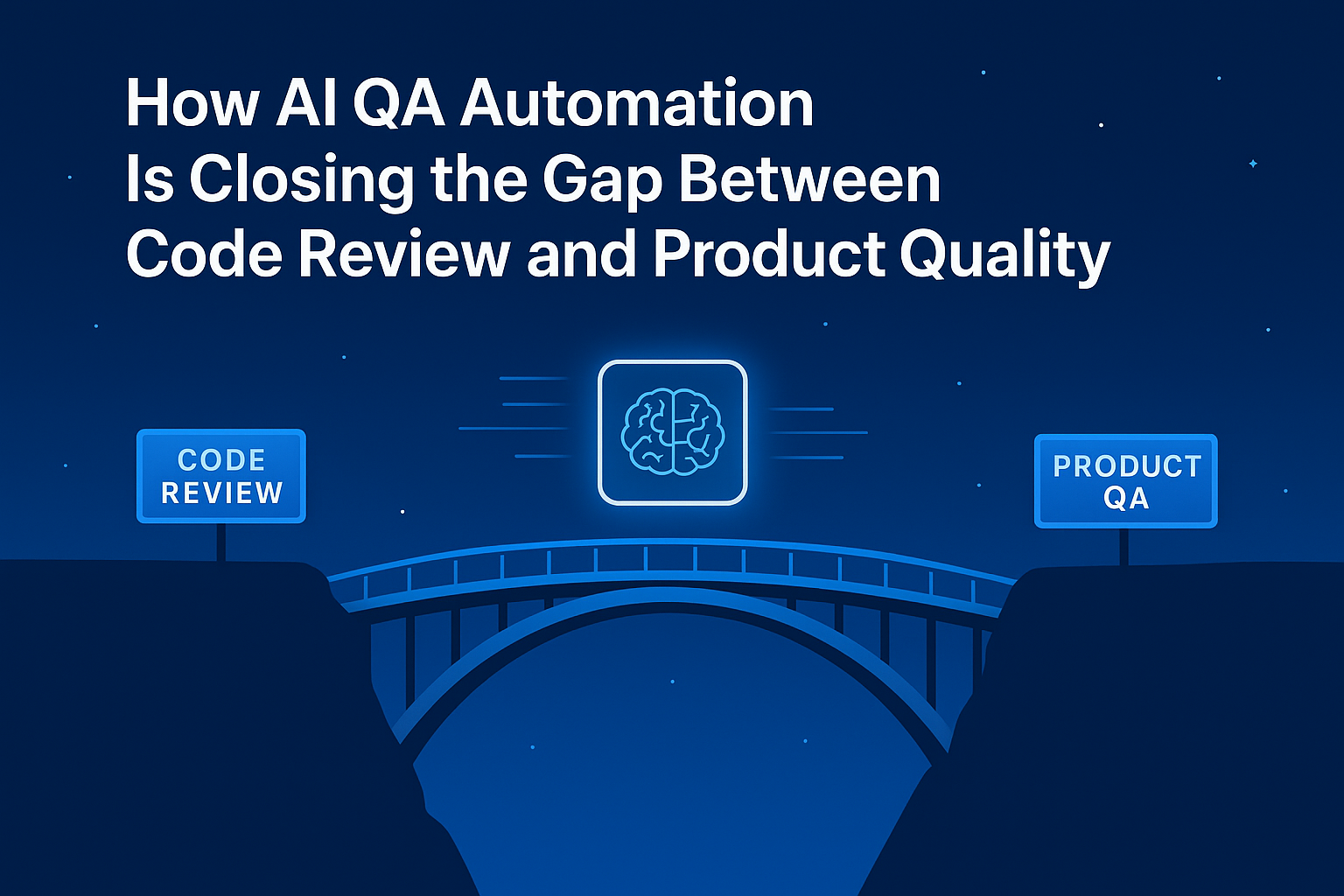In software engineering, quality has always been the currency of trust. Every release, sprint, and deployment carries an implicit promise: that what ships will work as expected, perform under load, and scale without breaking. Yet as teams move faster, build more complex systems, and ship continuously, traditional testing and QA models have begun to show their limits.
Enter the new era of vibe debugging and quality assurance—a convergence of AI code review, automated testing, and intelligent QA orchestration that transforms the software lifecycle into a continuous feedback loop rather than a sequence of disconnected stages.
This transformation isn’t just about speed. It’s about closing the loop between code quality at commit time and product quality in production—creating an ecosystem where AI agents can see, learn, and adapt across the full stack of software delivery.
The Broken Loop: Why Traditional QA Struggles to Keep Up
For decades, QA has been a reactive discipline. Developers write code, QA tests it, issues are logged, and patches follow later. Even as CI/CD pipelines reduced cycle times, the feedback from end-to-end testing still lagged behind code changes.
Common symptoms of a broken loop include:
- Context gaps: QA teams find issues but can’t see the code context or intent behind them.
- Late feedback: Defects surface days or weeks after the code was written, making fixes costlier.
- Manual triage: Human reviewers wade through false positives or repeated regressions.
- Missed learning opportunities: Each defect teaches something, yet that learning rarely feeds back into development workflows.
These inefficiencies add up. Industry research consistently shows that the cost to fix a defect increases 10× between coding and post-release stages. Meanwhile, developer velocity drops as cognitive load grows—especially in organizations managing hundreds of microservices or multiple mobile platforms.
AI Code Review: The First Wave of Intelligent Quality
The first tangible application of AI in this space was AI code review. By analyzing pull requests, commit patterns, and historical defects, these systems began to predict likely problem areas before QA even saw them.
Unlike static linters, modern AI code reviewers learn from the entire organization’s codebase. They don’t just enforce style—they assess intent, comparing new code against historical bug clusters and architectural patterns.
Some measurable outcomes from early adopters:
- 30–40% reduction in post-merge defects.
- 20–25% faster reviews due to AI triage of low-risk changes.
- Improved developer onboarding, since AI reviewers surface historical rationale and best practices.
But even with smarter code review, the feedback loop still ended at the merge. Testing and QA remained siloed, consuming insights rather than contributing to them.
AI Testing: Making the Codebase Itself a Living Lab
The second wave came with AI-augmented testing (or vibe debugging) —tools that use machine learning to generate, adapt, and prioritize tests dynamically.
Instead of writing thousands of brittle test cases, teams can now rely on AI-generated tests based on code semantics, user behavior, and production telemetry. When a new feature lands, AI models infer the most likely failure paths and automatically design tests to probe them.
Examples of how this changes QA practice:
- Adaptive test coverage: AI learns which areas of the code are most volatile or business-critical and allocates more test depth there.
- Autonomous test maintenance: As UI elements, APIs, or data structures evolve, AI updates test scripts automatically—reducing “test rot.”
- Predictive defect detection: By mapping historical code change patterns to past incidents, AI flags commits that carry a higher probability of regressions.
These advances turn QA from a static checkpoint into a dynamic learning system. The AI isn’t just testing software—it’s learning how the team writes, changes, and deploys code.
From Silos to Systems: The Rise of Continuous Quality Loops
When AI code review and AI testing converge, something profound happens: testing becomes an extension of coding, and QA becomes an extension of deployment.
Imagine a loop like this:
- AI Code Review identifies likely defect patterns before merge.
- AI-powered QA Testing Systems automatically design and run targeted tests based on those predictions.
- AI QA Agents monitor live environments, detect anomalies, and feed them back into the code review model.
- Developers get intelligent insights—not just bug reports, but the why behind recurring issues.
The result is a self-reinforcing quality ecosystem where every stage informs the next. Instead of testing after development, testing evolves with development—and the insights flow both ways.
This approach directly supports metrics that matter:
- Defect discovery time: Reduced by up to 60%.
- Time-to-resolution: Shrinks as feedback arrives while code context is still fresh.
- Post-release incidents: Decline sharply due to preemptive testing and targeted QA.
- Developer satisfaction: Increases as repetitive review work is automated.
Integrating AI Into the DevOps Pipeline
For most engineering leaders, the question isn’t whether to adopt AI in QA—it’s how.
The integration roadmap typically follows these layers:
- Static + Semantic Analysis: Introduce AI code reviewers that learn from your repositories and historical bugs.
- Intelligent Test Generation: Add AI tools to expand coverage and maintain test resilience.
- AI-Powered QA Dashboards: Aggregate insights from reviews, tests, and runtime telemetry into a unified quality index.
- Closed-Loop Feedback: Automate the flow of production incidents back into pre-deployment AI models.
Each stage amplifies the previous one, compounding quality improvements. The goal is not to replace developers or testers—but to augment their judgment with data-driven foresight.
Metrics That Matter: Quantifying the Quality Loop
In thought-leadership terms, the argument for AI in QA isn’t philosophical—it’s empirical. Organizations that successfully implement closed quality loops often measure impact along four key dimensions:
| Metrics | Pre-AI Baseline | After AI Integration | Improvement |
|---|---|---|---|
| Mean Time to Detect (MTTD) | 2.5 days | 0.9 days | 64% faster |
| Mean Time to Resolve (MTTR) | 1.8 days | 0.7 days | 61% faster |
| Escaped Defects per Release | 7–9 | 2–3 | 65% reduction |
| Developer Hours on Review/Test | 32 hrs/sprint | 19 hrs/sprint | 41% efficiency gain |
These metrics are not hypothetical—they reflect a growing body of case data from teams applying AI-driven code intelligence and QA orchestration across CI/CD pipelines.
What’s striking isn’t just the reduction in defects; it’s the improvement in learning velocity. Each iteration of the AI model gets smarter, compressing feedback cycles further.
AI QA Adoption: Implementation Roadmap
Organizations aiming to adopt AI in QA need a structured, actionable plan. A clear implementation roadmap guides teams through stages from readiness assessment to full integration of AI-powered debugging.
Key steps include evaluating current processes, piloting intelligent testing solutions, and measuring impact with meaningful metrics.
- Readiness Assessment: Start by evaluating QA maturity and testing pain points. Identify opportunities for intelligent testing and ensure your data and infrastructure support software testing automation.
- AI Model Onboarding: Select or train AI models on domain-specific test data. Onboard AI-powered QA tools through pilot projects to validate performance and build trust, iterating on models with feedback from engineers and testers.
- CI/CD Pipeline Integration: Integrate AI-driven testing into continuous integration and delivery workflows. Automate test execution and results analysis within your build pipeline, enabling faster feedback loops and more reliable releases.
- Training & Human-in-the-Loop: Train QA and development teams on new AI testing capabilities and maintain human oversight. Encourage collaboration where AI handles repetitive tasks and humans tackle complex scenarios, ensuring the models learn from real-world feedback.
- Metrics & Optimization: Define KPIs such as defect detection rate, test coverage, and release cycle time. Continuously monitor performance, refine AI models, and adjust processes to maximize ROI from automation.
Benefits of Intelligent Testing vs Risks of Traditional QA
Adopting AI-powered QA tools brings competitive advantages, while sticking with legacy processes poses risks. Intelligent testing accelerates defect detection and boosts developer velocity, whereas traditional debugging can lead to slower releases and undetected bugs.
- Accelerated Defect Detection: AI algorithms analyze test results at scale and spot patterns humans might miss, catching defects earlier and reducing post-release fixes.
- Higher Developer Velocity: Automated, intelligent testing frees developers from manual test maintenance, shortening release cycles and accelerating innovation.
- Competitive Edge with Automation: Organizations embracing AI QA adoption continuously improve resilience by optimizing test coverage and release reliability.
- Quality Gaps in Traditional QA: Manual QA often misses edge cases and anomalies, allowing bugs to slip into production, causing costly rework and eroding user trust.
- Slower Innovation: Without AI-driven test automation, feedback loops lengthen and releases slow down—teams risk falling behind competitors leveraging intelligent testing.
Panto AI and the Perfect Feedback Loop
One emerging example of this vision in action is Panto AI’s new end-to-end “vibe debugging” mobile QA solution, designed to close the feedback loop between code review and live quality.
By connecting AI-based code analysis with automated mobile testing and runtime behavior capture, Panto AI creates a continuous diagnostic cycle. When a bug appears in production, the system not only identifies it—it traces it back to the originating code context, flags similar risky patterns, and updates its own AI models accordingly.
This “vibe debugging” approach embodies the ideal of adaptive QA: where every test, every review, and every deployment makes the system more intelligent. It’s not just automation—it’s reinforcement learning embedded directly into the developer workflow.
Challenges and Guardrails
Of course, AI-driven QA isn’t without challenges. Organizations should anticipate and plan for:
- Code retention and code security – AI models trained on proprietary repositories must ensure isolation and compliance.
- False positives/negatives – No AI is perfect; human oversight remains essential.
- Model drift – As codebases evolve, AI models require retraining to maintain accuracy.
- Cultural adoption – Teams must trust AI insights and adapt processes around them.
The best results come from human-in-the-loop systems—where AI accelerates discovery, but humans retain final judgment.
The Future: Toward Autonomous Quality
Looking forward, the convergence of AI and QA will move beyond automation toward autonomy. Future systems will:
- Auto-remediate minor defects, opening pull requests autonomously.
- Continuously benchmark quality metrics against similar codebases across industries.
- Predict incident probabilities before deployments based on real-time data.
- Collaborate through agents, where AI reviewers, testers, and observability bots communicate to optimize outcomes.
Conclusion: Closing the Loop Is the Real Revolution
The real promise of AI in testing and QA isn’t just automation or cost savings. It’s the unification of quality intelligence across the software lifecycle.
When AI code review, testing, and QA operate as one adaptive system, teams don’t just detect defects—they prevent them, understand them, and evolve from them. Every deployment becomes a feedback event; every bug becomes new training data.
This is what it means to close the loop between code and quality:
to make software that continuously improves itself—driven by AI, guided by humans, and measured by the impact it has in the real world.






